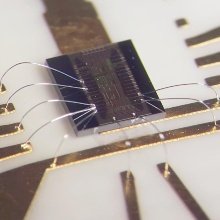4.6 billion years ago, our solar system was born out of an interstellar dust- and gas cloud. Therefore by analyzing interstellar and other cosmic dust particles we can develop a better understanding of the conditions during the development of our solar system.
A common way to determine the origin of cosmic dust particles is to evaluate charges induced in an electrode-array during the fly-by of the particle. This technique utilizes the natural charge-up of particles trough solar UV-radiation in space. Unfortunately the charge of the particles is in the range of only a couple to a few thousand electros. Therefore extremely sensitive detectors and amplifiers are needed.
In a joint effort with IRS/University of Stuttgart, INT researches different methods to improve both the noise level and the bandwidth of the detection systems. One approach thereby focusses on the development of a better understanding of the interactions of the separate system components by creating a system-wide model, containing all subcomponents.
The work on INT focuses on minimizing the noise occurring in these amplifiers while maintaining a bandwidth of 7 Hz to 300 kHz or 10 kHz to 10 MHz. The goal is to be able to detect particles whose charge is in the range of only about 100 elementary charges.
In terms of circuit design the efforts focus both on researching noise reduction techniques for charge amplifiers and on increasing the bandwidth both to lower and higher frequencies by employing new circuit topologies. Significant improvements can often already be reached by utilizing the optimum process technology for a given frequency range.
Charge Sensitive Amplifier Circuit with 50 MHz bandwidth
This chip contains a charge sensitive amplifier (CSA) for charge induction based dust particle detection in space. The circuit features a bandwidth of up to 50 MHz and is therefore most suitable for very fast particles. A special feature of this amplifier is the possibility to adjust the capacitance of the input transistor by configuring several amplifiers in parallel. This enables the user to match the input capacitance to the capacitance of the detector to optimize the noise performance. In a system with a detector capacitance of 4 pF and a frequency range from 1 kHz to 50 MHz the CSA achieves an ENC of 332 elementary charges. This circuit is fabricated in a 130 nm CMOS technology.
Publications
2024
- S. Kelz, “Auslegung von Detektoren und Ladungsverstärkern für die Erkennung geladener Partikel unter Berücksichtigung des Systemverhaltens,” Dissertation, 2024.
2023
- Y. Li, M. Bauer, S. Kelz, H. Strack, J. Simolka, C. Mazur, M. Sommer, A. Mocker, and R. Srama, “Upgrades of a Small Electrostatic Dust Accelerator at the University of Stuttgart,” Applied Sciences, vol. 13, p. 4441, 2023.
2021
- S. Kelz, M. Grözing, and M. Berroth, “Experimental Investigation of Dielectric Loss Induced Noise in Charge Detection Systems for Cosmic Dust,” in Conference on Ph.D. Research in Microelectronics and Electronics (PRIME), 2021, pp. 288–291.
2019
- S. Kelz, M. Grözing, and M. Berroth, “Dielectric-Loss Induced Noise in High Impedance Circuits,” presented at 21. Workshop Analogschaltungen, Stuttgart, Germany, 2019.
2018
- S. Kelz, “A Fully Differential Charge-Sensitive Amplifier for Dust-Particle Detectors,” presented at 20. Workshop Analogschaltungen, Freiburg, Germany, 2018.
- S. Kelz, T. Veigel, M. Grözing, and M. Berroth, “A Fully Differential Charge-Sensitive Amplifier for Dust-Particle Detectors,” in Conference on Ph.D. Research in Microelectronics and Electronics (PRIME), Prague, Czech Republic, 2018, p. pp. 13––16.
Additional Information
- Institute of Space Systems (IRS)
Cosmic Dust [german] - DFG Project
Extremely low noise integrated charge sensitive amplifiers for electrostatic influence based detectors for cosmic and terrestrial dust
Contact

Markus Grözing
Dr.-Ing.Group Leader Integrated Circuits






